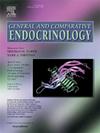Genetic ablation of Pth4 disrupts calcium-phosphate balance, bone development, and kidney transcriptome in teleosts
IF 1.7
3区 医学
Q3 ENDOCRINOLOGY & METABOLISM
引用次数: 0
Abstract
Parathyroid hormone 4 (Pth4) is an evolutionarily conserved member of the PTH family, expressed in hypothalamic neurons and lost in eutherian mammals. In order to elucidate its role in mineral homeostasis and skeletal development, a pth4 knockout (pth4KO) zebrafish line was generated using CRISPR/Cas9 and transcriptomic profiling was conducted across six key tissues: brain, kidney, intestine, gills, scales, and bone. The results obtained demonstrated that the loss of Pth4 led to pronounced disturbances in calcium and phosphate homeostasis, skeletal deformities, and widespread tissue-specific transcriptional alterations. Notably, dysregulation of mineral regulatory genes—such as fgf23, phex, and slc34a1a was particularly evident in the kidney, suggesting disruption of the FGF23-Klotho axis. In parallel, differential expression of extracellular matrix genes (col1a1a, col10a1a, col11a1) and matrix remodeling enzymes (mmp9, mmp13a, mmp2) in bone and scales indicated impaired skeletal remodeling. Together, these findings highlight a pivotal role for Pth4 in the endocrine and local regulation of mineral metabolism and skeletal integrity, expanding our understanding of PTH family functions in vertebrate physiology.
基因消融Pth4破坏硬骨鱼钙-磷酸盐平衡、骨骼发育和肾脏转录组
甲状旁腺激素4 (Pth4)是PTH家族中进化上保守的成员,在下丘脑神经元中表达,在哺乳动物中缺失。为了阐明其在矿物质稳态和骨骼发育中的作用,使用CRISPR/Cas9生成了pth4敲除(pth4KO)斑马鱼系,并在6个关键组织(脑、肾、肠、鳃、鳞片和骨骼)中进行了转录组学分析。获得的结果表明,Pth4的缺失导致钙和磷酸盐稳态的明显紊乱,骨骼畸形和广泛的组织特异性转录改变。值得注意的是,矿物质调节基因(如fgf23、phex和slc34a1a)的失调在肾脏中尤为明显,这表明fgf23 - klotho轴受到破坏。与此同时,骨和鳞片细胞外基质基因(col1a1a、col10a1a、col11a1)和基质重塑酶(mmp9、mmp13a、mmp2)的差异表达表明骨骼重塑受损。总之,这些发现突出了Pth4在内分泌和矿物质代谢和骨骼完整性的局部调节中的关键作用,扩大了我们对PTH家族在脊椎动物生理学中的功能的理解。
本文章由计算机程序翻译,如有差异,请以英文原文为准。
求助全文
约1分钟内获得全文
求助全文
来源期刊

General and comparative endocrinology
医学-内分泌学与代谢
CiteScore
5.60
自引率
7.40%
发文量
120
审稿时长
2 months
期刊介绍:
General and Comparative Endocrinology publishes articles concerned with the many complexities of vertebrate and invertebrate endocrine systems at the sub-molecular, molecular, cellular and organismal levels of analysis.
 求助内容:
求助内容: 应助结果提醒方式:
应助结果提醒方式:


